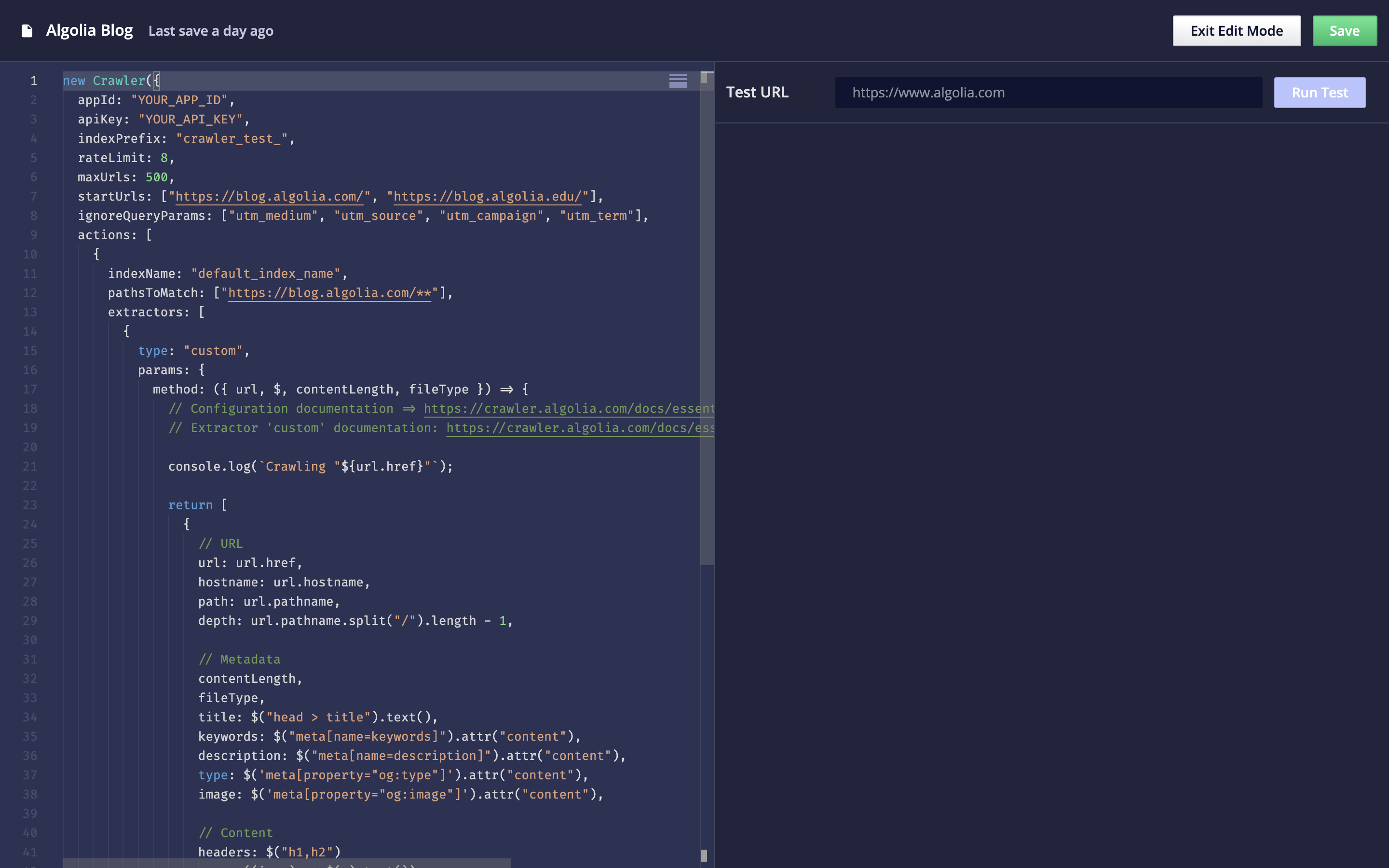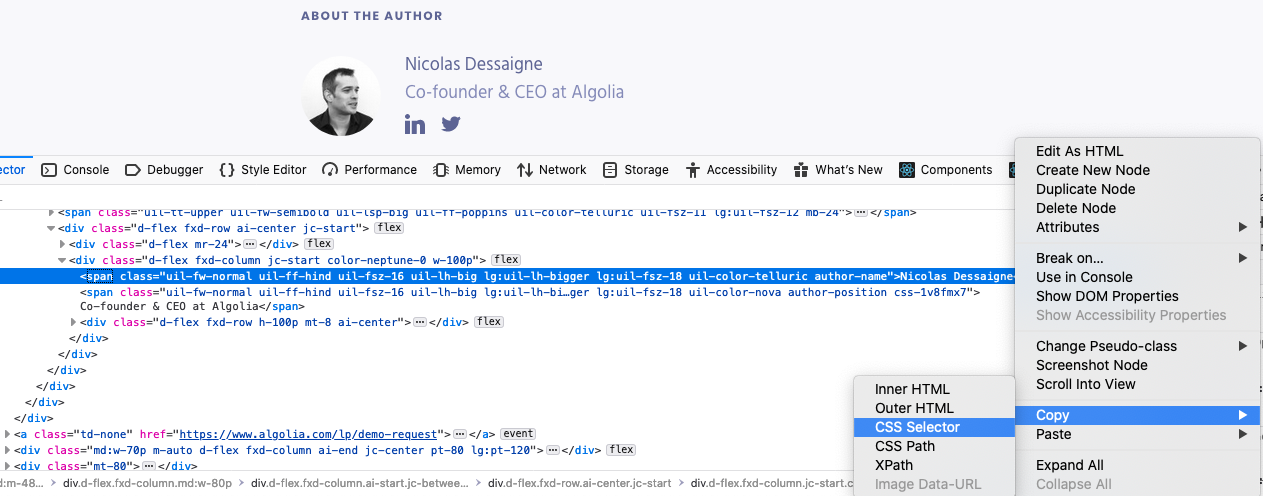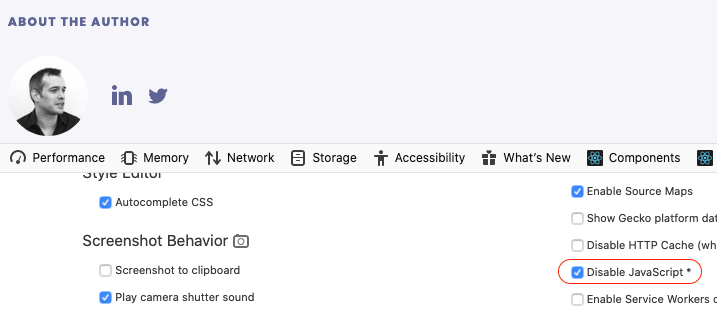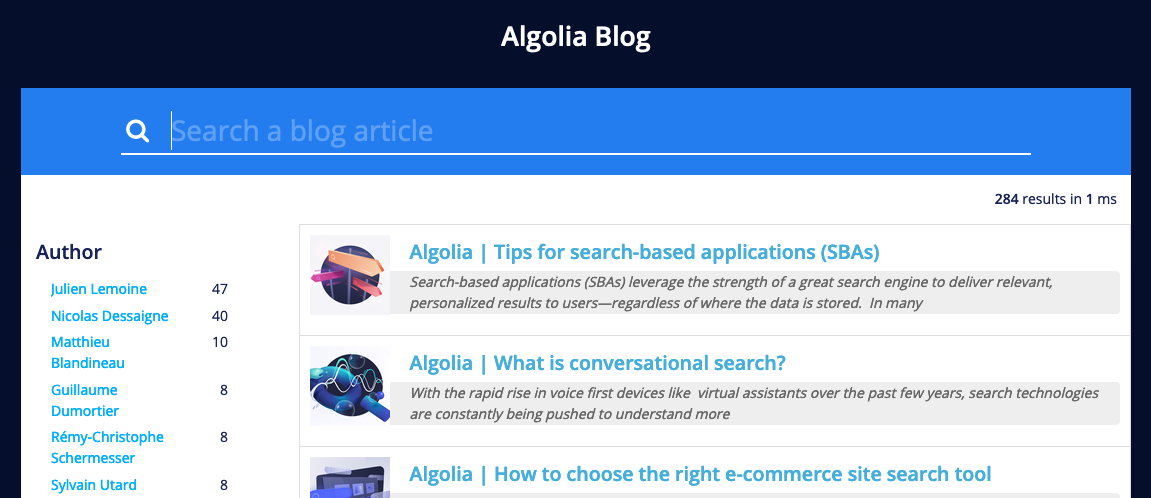How to Configure Your First Crawler
Running your first crawl only takes a few minutes. However, the default configuration only extracts a few common attributes, such as a title, a description, headers, and images. You want to modify and optimize it for your own website:
- The default extractor might not work as-is with your website, if the data is not formatted the same way.
- You want to extract more content so your users can discover it.
In this how-to guide, we will iterate on our Algolia blog default configuration, and see several tips and tricks to help you build and optimize your crawler.
What is the Crawler Configuration API?
You can find a full reference for the Crawler Configuration API. To edit your Crawler’s configuration, use the code editor in the Crawler Admin. You can also test your current crawler configuration with the Test URL section of the code editor.
How do you access a crawler’ configuration?
A crawler’s configuration is accessed through the Editor tab of the Crawler Admin. After selecting or creating a crawler, click on the Editor tab. This takes you to an in-browser code editor.
We will refer to the file you edit in-browser as the configuration file. This file contains your crawler object, whose parameters are listed and in the Crawler Configuration API.

How do you use the Configuration API?
You can consult the complete Configuration API reference. To edit your Crawler’s configuration, use the code editor in the Crawler Admin. You can also test your current crawler configuration with the Test URL section of the code editor.
Configuring the entry points
startUrls
Giving the correct entry points to the crawler is crucial. The default configuration only contains the base URL that was set when creating a crawler. If we run our crawler as-is, we end up with only a few discovered pages. This is because the homepage of the Algolia blog only display the most recent articles, and provides a “See More” button at the bottom of the page to dynamically load more posts.
The Crawler can’t interact with webpages. For that reason, it’s limited to the first few articles displayed on the homepage. The best solution in our case is to rely on a sitemap.
sitemaps
One of the first things to look for when you want to exhaustively crawl a website is whether a sitemap is available. Sitemaps are specifically intended for web crawlers, they provide a complete list of all relevant pages that should be discovered. When using a sitemap, you’re sure that your crawler won’t miss any URL.
The location of the sitemap is generally specified in the robots.txt file, a standard file located at the root level of a website, to inform the web crawlers which areas of the website they’re allowed to visit.
Sitemaps usually go at the root level of the website too, in a file named sitemap.xml.
Let’s remove the startUrls and instead add the Algolia blog sitemap to our configuration:
1
2
3
4
5
new Crawler({
- startUrls: ["https://blog.algolia.com/"],
+ sitemaps: ["https://blog.algolia.com/sitemap.xml"],
// ...
});
When we run a new crawl with this sitemap added to our crawler configuration, we end up with several hundred records.
Finding data on web pages
Now that all our blog pages are indexed, we can start looking at putting more data in our generated records, to improve discoverability.
CSS selectors
The main way to extract data on a web page is by using a CSS selector. To find the correct one, browse the URLs you want to crawl and scroll to the information you want to extract. Here, we want to get the author of each article:
- Right click on the text to extract and select Inspect Element (or Inspect).
- In the browser console, right click on the highlighted HTML node and select Copy > CSS Selector

Depending on the browser, the generated selector might be complex and may be incompatible with Cheerio. In that case you have to manually craft it.
The selector also needs to be common to all the pages visited by this recordExtractor. We can use the URL Tester to check the result.
With Firefox, we get the following selector: .author-name. Let’s test it in the URL Tester:
- Add the following field to the record returned by the
recordExtractormethod:Copy1
author: $(".author-name").text(),
- With the URL Tester, run a test for one of the blog articles (e.g.
https://blog.algolia.com/algolia-series-c-2019-funding/).
In the logs, we see the following generated record:
1
author: ""
This means the author field wasn’t properly retrieved. Let’s try to understand why.
Debugging selectors
With the console
A simple way to debug selector is to use the console. The recordExtractor lets you use console.log, and displays the output in the Logs tab of the URL Tester.
1
console.log($(".author-name").text());
In your browser
To understand why the Crawler cannot extract the information, we can use the developer tools of the browser. Open the developer console:
- In Firefox: Tools > Web Developer > Web Console
- In Chrome: View > Developer > JavaScript Console
And test your selector using the DOM API: You should retrieve the HTML element containing the author name.

So what else is the Crawler missing?
Check if JavaScript is required
The difference between what you see in a browser and what the Crawler sees often comes from the fact that JavaScript is not enabled by default on the Crawler. JavaScript makes websites slower and consume more resources, so we let it up to you to enable it on your crawler.
Let’s try to display our page without JavaScript:
- In the browser console, click on the three dots on the right and select Settings
- Find the
Disable JavaScriptcheckbox and tick it.- If you’re using Chrome, reload the page.
Now if we look at the author section, we can see that the author name is missing.

This is why the Crawler can’t extract it: our blog articles need JavaScript to display all the information.
To fix that, enable JavaScript in your crawler for all blog entries with the renderJavaScript option:
1
2
3
new Crawler({
+ renderJavaScript: ['https://blog.algolia.com/*'],
});
When we run a new test on the same blog article, we can now see that the author field is correctly populated.
There is often a better way to get that information without enabling JavaScript: meta tags.
Meta tags
Websites often include many useful information in their meta tags, so they can index well in search engines and social media. There are several types:
- Standard HTML meta tags.
- Open Graph, a protocol originally developed by Facebook to let people share web pages more easily on social media. The information it exposes is clean and expected to be searchable. If the website you want to crawl has Open Graph tags, you should use them.
- Twitter Card Tags, which is similar to Open Graph but specific to Twitter.
Let’s look at a few other meta tags that the Algolia blog exposes. You can do this either on the Inspector tab of the developers tools, or by right-clicking anywhere on the page and selecting View Page Source.
1
2
3
4
<meta content="Algolia | Onward! Announcing Algolia’s $110 Million in New Funding" property="og:title"/>
<meta content="Today, we announced our latest round of funding of $110 million with our lead investor Accel and new investor Salesforce Ventures along with many others. In" name="description"/>
<meta content="https://blog-api.algolia.com/wp-content/uploads/2019/10/09-2019_Serie-C-announcement-01-2.png" property="og:image"/>
<meta content="Nicolas Dessaigne" name="author"/>
This information is directly readable without JavaScript. You can see that the default configuration already includes some of them.
We can thus remove the renderJavaScript option and update our configuration to get the author using this tag:
1
$("meta[name=author]").attr("content"),
Remember that $ is a Cheerio instance that let you manipulate crawled data. You can find out more about their API.
Improved configuration
Our improved blog configuration now looks like the following:
1
2
3
4
5
6
7
8
9
10
11
12
13
14
15
16
17
18
19
20
21
22
23
24
25
26
27
28
29
30
31
32
33
34
35
36
new Crawler({
appId: "YOUR_APP_ID",
apiKey: "YOUR_API_KEY",
indexPrefix: "crawler_",
rateLimit: 8,
sitemaps: ["https://blog.algolia.com/sitemap.xml"],
ignoreQueryParams: ["utm_medium", "utm_source", "utm_campaign", "utm_term"],
actions: [
{
indexName: "algolia_blog",
pathsToMatch: ["https://blog.algolia.com/**"],
recordExtractor: ({ url, $, contentLength, fileType }) => {
return [
{
// The URL of the page
url: url.href,
// The metadata
title: $('meta[property="og:title"]').attr("content"),
author: $('meta[name="author"]').attr("content"),
image: $('meta[property="og:image"]').attr("content"),
keywords: $("meta[name=keywords]").attr("content"),
description: $("meta[name=description]").attr("content"),
}
];
}
}
],
initialIndexSettings: {
algolia_blog: {
searchableAttributes: ["title", "author", "description"],
customRanking: ["desc(date)"],
attributesForFaceting: ["author"]
}
}
});
Next steps
Having the author enables us to add faceting to our search implementation.

Interesting next steps would be:
- Indexing the article content to improve the discoverability.
- Indexing data that lets us add custom Ranking, such as the publish date of the article, or Google Analytics data to boost the most popular articles.
- Indexing additional information about the author, such as their picture and job title.
- Set up a
scheduleto have the blog crawled on a regular basis.
Configurations examples
If you want to get a better sense of how to use and format crawler configurations, checkout our Github repository of sample configuration files.
